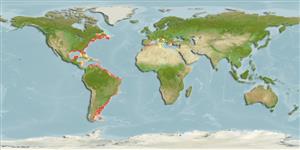Bivalvia |
Ostreida |
Ostreidae
Environment: milieu / climate zone / пределы глубины / distribution range
экология
; солоноватоводный; пределы глубины 0 - 79 m (ссылка 83435). Subtropical, preferred 22°C (ссылка 107945)
Western Atlantic and the Mediterranean. Introduced in Northeast Atlantic and the Pacific Ocean.
Length at first maturity / Size / Weight / Возраст
половая зрелость: Lm ? range ? - ? cm Max length : 30.0 cm SHH самец/пол неопределен; (ссылка 271); наибольший возраст (опубликованны данные): 2.00 годы (ссылка 2823)
Diagnostic features: Shell thick and heavy, usually narrow and elongate, but extremely variable in shape. Upper valve flatter, smaller than lower valve; lower valve convex. Shell shape and outline variable. Shell margins undulating straight. Umbones long and curved. Colour: dirty to light grey, internally white with muscle scar deep purple (Ref. 271).
################ Attached to rocks, other oyster shells, or other hard substrates (Ref. 271). Favors estuaries and embayments with low salinities and are intolerant of prolonged exposure to fresh water or marine conditions. They may either be filter feeders (Ref. 96280) or suspension feeders (Ref. 3248). Found in shallow water of tidal to subtidal depth of fairly constant turbidity and salinity (Ref. 3248) and salt marshes (Ref. 2823). Main sources of food are phytoplankton, suspended detritus particles (Ref. 96280) and bacteria (Ref. 101343). Able to regulate its feeding rates based on differences in size, type and composition of the food source (Ref. 96280).
Gonochoristic (separate male and females). After external fertilization, the developing larvae or veliger settles to the bottom after a time in the plankton stage. First spawning usually occurs when oyster is two years of age (Ref. 3248).
Основная ссылка
ссылки | координатор | соавторы
Carpenter, K.E. (ed.) 2002 The living marine resources of the Western Central Atlantic. Volume 1: Introduction, molluscs, crustaceans, hagfishes, sharks, batoid fishes, and chimaeras. FAO Species Identification Guide for Fishery Purposes and American Society of Ichthyologists and Herpetologists Special Publication No. 5, Rome. 600p. (ссылка 271)
Статус Красного Списка МСОП
(ссылка 130435: Version 2025-1)
Статус СИТЕС (ссылка 108899)
Not Evaluated
CMS (ссылка 116361)
Not Evaluated
Угроза для людей
Использование человеком
рыболовство: коммерческий; аквакультура (рыбоводство): коммерческий
FAO - аквакультура (рыбоводство): production, Видовой профиль; рыболовство: landings, Видовой профиль | FishSource | Sea Around Us
инструменты
дополнительная информация
PhysiologyOxygen consumption
Human RelatedStamps, coins, misc.
ресурсы в Интернет
Estimates based on models
Preferred temperature
(Ref.
115969): 7.7 - 27.5, mean 23.5 (based on 794 cells).
Prior r = 0.72, 95% CL = 0.47 - 1.07, Based on 1 full stock assessment.
Fishing Vulnerability
Low to moderate vulnerability (26 of 100).
Climate Vulnerability
High vulnerability (57 of 100).
Nutrients : Calcium = 149 [71, 228] mg/100g; Iron = 8.53 [1.95, 15.11] mg/100g; Protein = 9.88 [8.64, 11.12] %; Omega3 = 0.313 [0.202, 0.423] g/100g; Selenium = 61 [50, 72] μg/100g; VitaminA = 0 μg/100g; Zinc = 2.04 [0.56, 3.51] mg/100g (wet weight); based on
nutrient studies.
